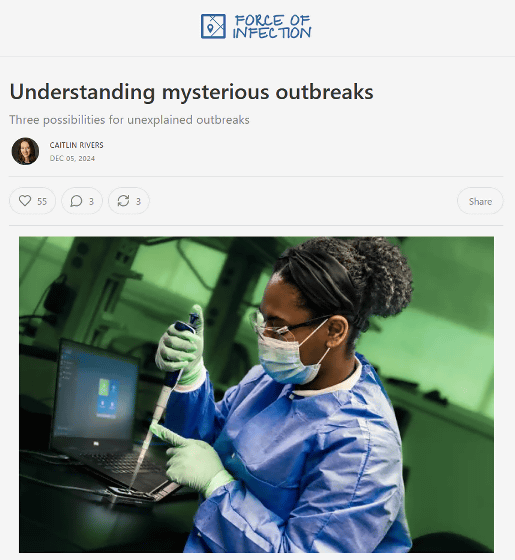What are the three possibilities when a mysterious infectious disease suddenly begins to spread?

In
Understanding mysterious outbreaks - by Caitlin Rivers
https://caitlinrivers.substack.com/p/understanding-mysterious-outbreaks

News of 'mysterious diseases spreading in some parts of the world' is not uncommon. In addition to the case in the Democratic Republic of the Congo reported in December 2024 alone, a mysterious infectious disease outbreak was reported in Parwan Province in eastern Afghanistan in September, and a series of deaths from a mysterious fever-related illness have also been reported in Gujarat, India. Rivers claims that these 'mysterious infectious disease outbreaks' can be classified into three possibilities.
◆1: The true nature of the disease is 'unknown known'
The most likely case is when the disease is 'an endemic or common disease that has not been identified at the time of reporting, but is well known.' For example, cholera, malaria, influenza, etc. are prevalent in a particular area, and for some reason their identity is unknown, so they are reported as 'mysterious diseases spreading.'
'Outbreaks that occur in low-resource settings are 'unconfirmed' because they started in places that don't have the infrastructure to easily diagnose them. These are more likely to be 'mystery outbreaks,'' Rivers said. In this case, the outbreak is still dangerous, but we know how to combat the disease.
◆2: The true nature of the disease is a 'known unknown' pattern
The second possibility is that the disease is 'known to exist but is rare and poorly understood. This category includes
'In many cases, there are no vaccines or specific treatments for pathogens that fall into this category and instead must be controlled through non-pharmaceutical measures such as contact tracing, which becomes more difficult as the outbreak grows and the situation becomes more urgent,' Rivers said.
These outbreaks are reported as 'mystery disease epidemics' because the true nature of the disease cannot be determined with certainty in the early stages of an outbreak, as samples from patients cannot be diagnosed without being sent to specialized laboratories for analysis. As access to diagnostic technology and medical infrastructure improves, fewer diseases fall into this category, but the potential impact is large.

◆3: The true nature of the disease is 'Unknown unknowns'
The last pattern is when the true identity of the disease is 'a disease whose existence is completely unknown or unexpected.' This means that an unexpected and serious pathogen has occurred.
'These 'unknown unknowns' outbreaks often take longer to diagnose because they require extensive testing and investigation. While the chances of a 'mystery illness' falling into this category are low, it is not zero,' Rivers said.

Rivers noted that the time to diagnosis varies depending on where the disease originates, the availability of diagnostic resources, and the complexity of the disease itself, and can take anywhere from weeks to months. 'In any case, it's important not to jump to conclusions based on limited data,' he said.
Related Posts:
in Science, Posted by log1h_ik







